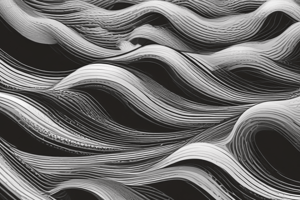Podcast
Questions and Answers
What is the direction of oscillations relative to the direction of energy transfer in transverse waves?
What is the direction of oscillations relative to the direction of energy transfer in transverse waves?
- Diagonal
- Parallel
- At an angle of 45 degrees
- Perpendicular (correct)
Which type of wave does not always require a medium to travel?
Which type of wave does not always require a medium to travel?
- Longitudinal wave
- Neither A nor B
- Transverse wave (correct)
- Both A and B
What is the characteristic of the oscillations in longitudinal waves?
What is the characteristic of the oscillations in longitudinal waves?
- They move in a zigzag pattern
- They move in a circular motion
- They move from side to side (correct)
- They move up and down
What is the primary function of waves?
What is the primary function of waves?
What happens to the medium as a wave passes through it?
What happens to the medium as a wave passes through it?
What is a common example of a longitudinal wave?
What is a common example of a longitudinal wave?
What is the primary characteristic of transverse waves?
What is the primary characteristic of transverse waves?
Ripples on the surface of water are an example of longitudinal waves.
Ripples on the surface of water are an example of longitudinal waves.
What is the primary function of longitudinal waves?
What is the primary function of longitudinal waves?
The oscillations in transverse waves move ______________, while the energy transfer is sideways.
The oscillations in transverse waves move ______________, while the energy transfer is sideways.
Match the following types of waves with their characteristics:
Match the following types of waves with their characteristics:
What is the motion of the wave in relation to the medium?
What is the motion of the wave in relation to the medium?
Flashcards are hidden until you start studying
Study Notes
Types of Waves
- Waves can be classified into two categories: transverse waves and longitudinal waves.
Transverse Waves
- Ripples on the surface of water are an example of transverse waves.
- In transverse waves, the oscillations are perpendicular to the direction of energy transfer.
- The oscillations move up and down, while the energy transfer is sideways.
- Transverse waves do not always require a medium to travel.
Longitudinal Waves
- Sound waves traveling through air are an example of longitudinal waves.
- In longitudinal waves, the oscillations are parallel to the direction of energy transfer.
- Longitudinal waves require a medium to travel, such as air, a liquid, or a solid.
- The oscillations move from side to side, with regions of compressions and rarefactions.
Key Features of Waves
- Waves always transfer energy from one place to another.
- For example, ripples transfer kinetic energy, and sound waves transfer sound energy.
Wave Movement
- It's the wave that moves, not the medium.
- The medium oscillates, but it does not travel along with the wave.
- This can be demonstrated using a slinky, which represents both transverse and longitudinal waves.
Types of Waves
- Waves can be classified into two main categories: transverse waves and longitudinal waves.
Transverse Waves
- Ripples on the surface of water are a classic example of transverse waves.
- Oscillations in transverse waves occur perpendicular to the direction of energy transfer.
- Energy is transferred sideways, while oscillations move up and down.
- Transverse waves can travel without a medium, unlike longitudinal waves.
Longitudinal Waves
- Sound waves traveling through air are a prime example of longitudinal waves.
- Oscillations in longitudinal waves occur parallel to the direction of energy transfer.
- Longitudinal waves require a medium to travel, such as air, a liquid, or a solid.
- Oscillations move from side to side, creating regions of compressions and rarefactions.
Key Features of Waves
- Waves always transfer energy from one place to another.
- Examples of energy transfer include kinetic energy (ripples) and sound energy (sound waves).
Wave Movement
- The wave itself moves, not the medium.
- The medium oscillates, but it does not travel along with the wave.
- This concept can be demonstrated using a slinky, which represents both transverse and longitudinal waves.
Types of Waves
- Waves can be classified into two main categories: transverse waves and longitudinal waves.
Transverse Waves
- Ripples on the surface of water are a classic example of transverse waves.
- Oscillations in transverse waves occur perpendicular to the direction of energy transfer.
- Energy is transferred sideways, while oscillations move up and down.
- Transverse waves can travel without a medium, unlike longitudinal waves.
Longitudinal Waves
- Sound waves traveling through air are a prime example of longitudinal waves.
- Oscillations in longitudinal waves occur parallel to the direction of energy transfer.
- Longitudinal waves require a medium to travel, such as air, a liquid, or a solid.
- Oscillations move from side to side, creating regions of compressions and rarefactions.
Key Features of Waves
- Waves always transfer energy from one place to another.
- Examples of energy transfer include kinetic energy (ripples) and sound energy (sound waves).
Wave Movement
- The wave itself moves, not the medium.
- The medium oscillates, but it does not travel along with the wave.
- This concept can be demonstrated using a slinky, which represents both transverse and longitudinal waves.
Studying That Suits You
Use AI to generate personalized quizzes and flashcards to suit your learning preferences.




